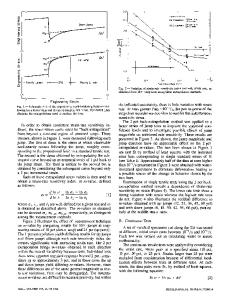Strain rate sensitivity in nanoindentation creep of hard materials
- PDF / 321,851 Bytes
- 5 Pages / 585 x 783 pts Page_size
- 78 Downloads / 370 Views
D.S. Stone Department of Materials Science and Engineering, University of Wisconsin–Madison, Madison, Wisconsin 53706 (Received 31 March 2007; accepted 29 June 2007)
This paper examines the strain rate sensitivity of the hardness H in relation to the strain rate sensitivity of the flow stress () in hard solids when there is friction between the indenter and specimen. Finite element analysis is used to simulate indentation creep of von Mises solids with a range of hardness/modulus ratios (H/E*) and coefficients of friction, , for indenter–specimen contact. We find that, although the level of H is affected by friction, the ratio H/ as a function of H/E* remains nearly unchanged. Measurements indicate that H ⳱ 0.015 ± 0.02 for fused silica, from which, based on the present analysis, ≈ 0.022 and from which an activation volume of 0.13 nm3 can be estimated for plastic deformation.
I. INTRODUCTION
This article addresses the relationship between strain rate sensitivity of the hardness and the strain rate sensitivity of the flow stress in hard solids like ceramics in the presence of specimen–indenter friction. A previous article examined the strain rate sensitivity of the hardness in the absence of friction.1 For many years there have been numerous investigations (Refs. 2–8) of hightemperature indentation creep in which the hardness (H) is a small fraction of the Young’s modulus (E). More recently the subject of indentation creep in hard solids has received increasing attention.9–15 For instance, Goldsby and co-workers10 utilized nanoindentation to measure room temperature creep in quartz (H/E ≈ 0.1– 0.15). Yoder and co-workers15 used indentation creep, indentation load relaxation, and indentation rate-change experiments to investigate deformation mechanisms in evaporated molybdenum coatings with hardness up to 12 GPa (H/E ≈ 0.04). Jang and Atzmon11 used indentation creep to investigate deformation mechanisms in nanophase iron with hardness up to 10 GPa (H/E ≈ 0.05). Hard metals like molybdenum and tungsten are known to be rate sensitive at room temperature, and for these and other metals the study of temperature- and rate-sensitive deformation has helped to advance what is known about
a)
Address all correspondence to this author. e-mail: [email protected] DOI: 10.1557/JMR.2007.0374 2912 J. Mater. Res., Vol. 22, No. 10, Oct 2007 http://journals.cambridge.org Downloaded: 19 Mar 2015
dislocation plasticity. Similar approaches should be able to provide useful information about deformation mechanisms in hard materials. Strain rate sensitivity measurements in hard solids are difficult because these materials tend to favor fracture over plastic deformation. Also, many of the materials of interest come in the form of thin films or other microscopic specimens, for which standard mechanical tests such as tension, compression, and shear are difficult to perform. With such materials it remains possible to use indentation creep experiments to characterize ratesensitive deformation because fracture is inhibited in these e
Data Loading...










